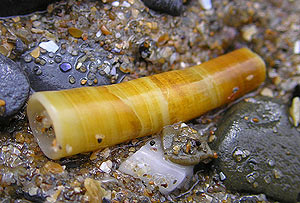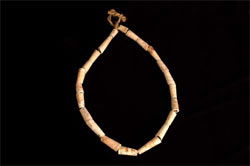Molluscs of Australia
| Tusk or Tooth Shells |
|
The tusk shells or Scaphopods, meaning "shovel-footed,. are a small class of shelled marine molluscs. Tusk shells range in size from a few millimetres to about 15 cm in length.
In Australia there are 108 species of Tusk shells of about 900 species found worldwide. Their habitats ranges from shallow waters to waters that are almost 5,000 metres deep. Their shells are cone-shaped, open at both ends and slightly curved making the shells look like tiny tusks.
All Scaphopods are marine, and live buried in mud or sand with their head end pointed downwards, where they feed on detritus, foramanifera, diatoms and microscopic animals. A tusk shell moves and searches for food with its buried head by extending its muscular foot outwards, then expanding a muscled disc that surrounds the far end of the foot. Once the disc is spread out, it will serve as an anchor for the scaphopod to pull against.
.
|

|
| |
|
They feed using tentacles with an adhesive "pad" at the tip to capture prey. TLittle hairs (cilia) along the tentacles move small food particles back to the mouth. The tentacles retract to bring larger food to the mouth. The radula is used to grind their food which is digested in the stomach, then travels to the intestine before passing to the anus. Their predators are fish and crabs.
The mantle tissue not only produces the shell, but also acts as gills ito get oxygen from seawater. Scaphopods are simple animals lacking a heart, blood vessels and eyes.
Tusk shells are either male or female and fertilisation is external. The female releases her eggs one at a time, and when they hatch, the young animal will go through two larval stages before settling into an adult form on the sea floor.
Tusk shells have been used to make belts, headdresses, necklaces and as money by tribal people in many parts of the world. |

|
Note: Foramanifera are marine protozoans with shells of calcium carbonate. Their shells have pores through which filaments project. Some form part of the plankton, others live on the sea bottom. References
http://en.wikipedia.org/wiki/Tusk_shell
www.ucmp.berkeley.edu/taxa/inverts/mollusca/scaphopoda.php
http://animaldiversity.ummz.umich.edu/site/accounts/information/Scaphopoda.html |
|